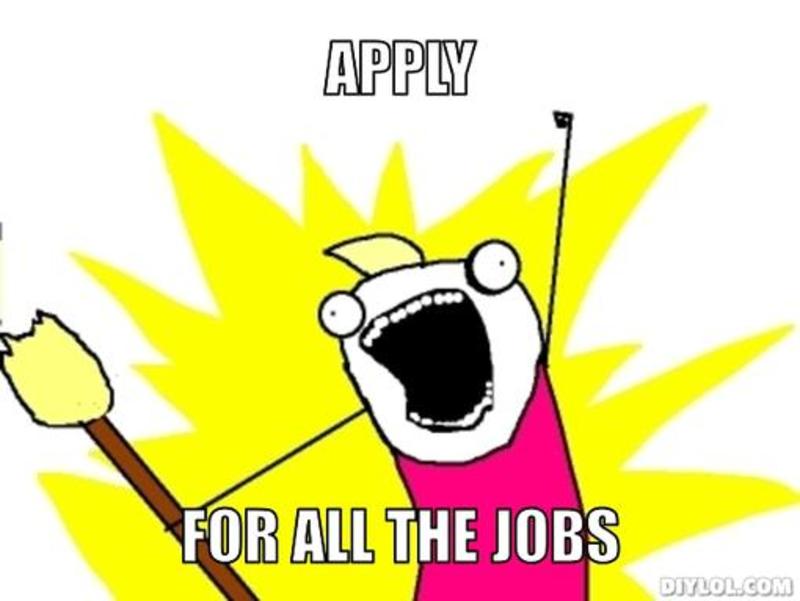You often know when you’ve just made a big mistake in your job application. You forget to attach your resume. You send the wrong version. You address your cover letter to Mr. Chris Allen-then realize there’s a strong chance Chris is a woman.
But other times, you have no idea-you may even think you’re doing everything right! In fact, there are a few common job search techniques that candidates employ over and over because they think they work well. In reality, though, these very same strategies might be standing in the way of you and that big interview.
To make sure you have the very best chances of inching closer to your dream job, here are four common blunders-and much more effective techniques to try instead.
1. Applying to as many jobs as you can possibly find
People often think that the job search is a numbers game. The more resumes you send out, the more likely it’ll be that someone will call you back, right?
Mmm, not really. Because applying to hundreds of jobs means you’re probably not taking the time to truly research the company and position, tailor each application accordingly, and reach out to current employees who might be able to give you insider information. (And if you are? I’m jealous of how many hours you must have in a day.)
 Similarly,
candidates sometimes believe that applying to multiple positions at
the same company ups their chances of getting called back for one
of them. In reality, though this sends one of three messages: That
you’re not sure what you want, that you’re desperate and you’ll
take anything, or that you don’t have a solid grasp on what each
job entails. In any case, not a good thing.
Similarly,
candidates sometimes believe that applying to multiple positions at
the same company ups their chances of getting called back for one
of them. In reality, though this sends one of three messages: That
you’re not sure what you want, that you’re desperate and you’ll
take anything, or that you don’t have a solid grasp on what each
job entails. In any case, not a good thing.
The Fix: Think quality, not quantity
Instead of applying to every semi-relevant job within a 60-mile radius, start your search by compiling a short list of dream companies and learning everything you can about them. When they have openings that fit your skill set, take the time to carefully craft your application-adjusting your resume bullets to show exactly how your experience aligns, writing a custom cover letter, and asking your new contacts if they have advice for standing out.
Yes, this approach takes more time and energy than submitting your same ol’ resume at over and over, but your chances of scoring an interview will be much, much higher.
2. Applying ASAP
OK, so you’ve narrowed down your list of companies, and one of them just posted a role that’s exactly in line with your skill set. Awesome! So you crank out everything as fast as possible and hit “send”-wanting to be the first application the hiring manager sees. Not only will you show just how excited you are about the job, but maybe the team will love your application so much they won’t need to interview anyone else.
News flash: This rarely does you any favors.
The Fix: Give it a day or so
Nine times out of 10, I have to toss the applications I receive within the first hour of posting a position because they’re incomplete. When you’re focused on speed over everything else, it’s easy to miss the details-getting names right, including additional materials, and so on. It’s better to give yourself a day or two to write, rewrite, and edit your materials, make sure you’ve included everything necessary, and have someone else look them over. (And, again, total bonus if you get advice from a current employee.) A stellar application will be better than a not-quite-there-but-prompt one, every time.

3. Sending your resume to people unsolicited
Let’s go back to those people who work at your dream companies for a second. Meeting them and getting on their radar: Good. Asking for their advice on working there: Also good. Sending them your resume unsolicited with a note that says, “Here’s my resume-let me know if you know of anything I’d be a fit for!” Surprisingly, not always the best.
Sure, in some cases, you might get lucky, but typically only in the off chance that the company is hiring for a role that meets your exact qualifications. But this move can also be construed as you asking your nice new contact (who’s already been helpful in talking to you about the company) to do the hard work for you-reviewing your resume, checking to see if any open positions are a fit, and forwarding along your information.
The Fix: Apply normally, then let your contact know
Yes, you can (and should) ask your contact for advice before you apply. And if, in the process, he or she offers to pass your resume or a recommendation along, that’s great. But never make this assumption. Take those tips you’ve learned and then do the hard work, just like any other candidate would do. Look at a company’s jobs page, find your dream role, then submit an application with all the required pieces.

4. Sending a great application for a job you’re not qualified for (fingers crossed)
Don’t get me wrong: I think everyone should apply to roles that are just a little bit of a stretch. It’s good to hava reach goals-plus, you might be more qualified than you think, and with preparation and a little bit of luck, you could land an interview.
But there’s a difference between applying for a slightly-out-of-reach job and one that you’ll never get. For example: an executive-level job when you’ve got three years of experience; heading up a department team of 10 when you’ve never managed anyone; applying for a product management role because you think it sounds cool, and hey-ou’ll figure it out. I’ve seen people in all of these situations think that they can make up for a lack of experience with passion and an awesome application, but the majority of the time, hiring managers think otherwise.
The Fix: Focus on the right reach jobs
Again, your time is much better spent applying to roles that line up nicely with your current skills and level of experience. Spend most of your efforts on roles for which you meet a good majority of the requirements, sprinkling in a few “reach” jobs here and there.
If you’re making a bit of a leap, read Muse writer Katie Douthwaite Wolf's advice on making sure you stand out among more qualified candidates. Or, work with a coach on a job search strategy that’ll help you get noticed.
Finally, consider career expert Kari Reston’s approach: “Instead of directly applying for the role that’s posted, send a speculative application to the company. Acknowledge that the position that caught your eye is geared toward someone more senior, but explain your interest and say that you’d be interested in joining the team in another capacity.”
I know-these job search techniques are done with the best of
intentions! But make sure you put yourself in the shoes of the
hiring manager. But applying to too many jobs too quickly, shooting
too high, or expecting others to do too much won’t have the results
you’re looking for. Try these simple shifts, and you’ll be much
more likely to get in the door for that interview.